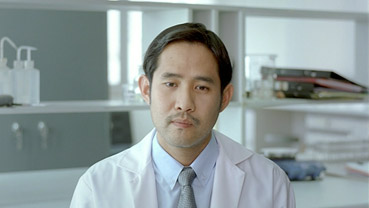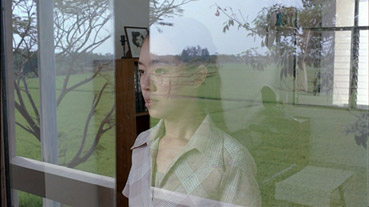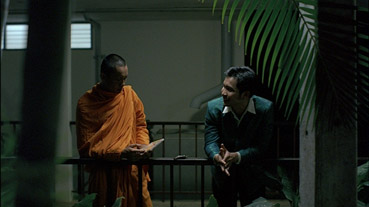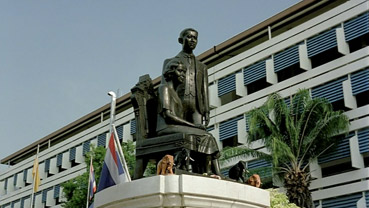|
If you had the pleasure of seeing Thai director Apichatpong Weerasethakul's 2004 film Tropical Malady [Sud pralad] in the cinema, then you may well have experienced the same collective sense of bemusement that accompanied the screening that I helped to organise. Midway through this gently observed tale of a young soldier and his relationship with a local country boy, a completely different story begins in which the same soldier finds himself hunted by a shape-shifting Shamen. Don't get me wrong, the audience may have been confused but they still willingly went with the switch, it just required a little more work on their part than they were used to investing.
This two-part structure is one that Weerasethakul appears to be becoming quite fond of. In his newest feature, Syndromes and a Century [Sang sattawat], we are again presented with two stories, but ones whose relationship to each other and juxtapositional purpose is clearer than it was in Tropical Malady. Syndromes paints an impressionistic portrait of two hospitals and a sprinkling of the characters that work and reside within. Now when I say two hospitals I actually mean one, with essentially the same establishment shown almost in two alternate realities and possibly even time periods, both containing the same medical practitioners, patients and encounters. The difference is one of location – in the film's first half, the hospital is located in a rural setting, in the second, it's in the heart of a bustling city.

Syndromes and a Century is the sort of film whose qualities are a genuinely hard to quantify, let alone sell to anyone apprehensive at the above outlined concept. Personal stories here are left deliberately unresolved, and their future directions only hinted at. Seemingly inconsequential moments are lingered on, conversations often lead nowhere specific, and a story that is recreated in flashback is neither concluded nor its teller revisited. And yet, like Tropical Malady before it, the film exerts a curious hold from its opening frames and has a strange fragmented logic, like a vivid picture of a place that has been assembled from broken and incomplete memories.
Several characters appear in both stories but with varying degrees of prominence. First shown being interviewed to camera for his post in the opening scenes of both stories, hesitant new arrival Dr. Nohng drops quickly into the background in the first half but is effectively the central character in the second, where a more confident figure emerges whose future plans are being mapped out for him by his more business-minded girlfriend. Young female doctor Toey, on the other hand, a key figure in the rural hospital story, all but disappears in part 2, where a scene from the first half in which she diagnoses an old monk who's plagued by dreams of vengeful chickens is replayed in the second with an older male doctor. The monk gives each of the doctors plant roots that he assures them will treat a number of ailments and "reduce inconsequential thoughts," an offering that only Toey is shown to make use of. The monk's younger companion is quick to correct his elder regarding his mother's asthma in Dr. Toey's company, but on the rerun appears too shy to speak. What's the significance of all or any of this? I'm genuinely not sure, but I greatly enjoyed the scenes in question and the speculation they prompted.
Elsewhere, the film is more direct about how location and surroundings can affect attitudes to life and others. In the rural hospital, a bond develops between dentist Dr. Ple and young monk Tohng, who is undergoing his first ever dental examination. During the course of their unhurried encounter the two discover a shared interest in music – Tohng once harboured ambitions to be a DJ, while Ple part-times as a singer. In one of the film's quietly humorous and seemingly improvised moments, Ple all but halts his dental work to croon to his amused patient, who asks of his doctor "Is this a check-up or a concert?" In the impersonal expanse of the city teaching hospital, however, a friendship between the two men is never on the cards – Ple is absorbed by the mechanics of the job and Tohng is irritated by the entire procedure, repeatedly removing the cloth placed over his eyes to shield them from the examination light.
The rural setting of the first half has an undeniably idyllic quality, a place where nature benignly dominates and the pace of life is attractively unhurried. Yet there is never the sense that this hospital is technologically lagging behind its big city cousin, rather that a balance has been struck here between nature and technology, the traditional and the modern, something that survives in the city only in the designated green spaces of parks and grounds. It's just one of many themes touched on in the course of the two stories, with the Buddhist concept of reincarnation figuring prominently, both as the subject of conversation and as one possible reading of the film's structure.

Weerasethakul's shooting and editing style mirrors the calm of his characters and storytelling. Observationally static for the most part, every now and then the camera goes on the move, unexpectedly following Nohng and his colleague's walk to the basement military wing in a long, unbroken hand-held shot (the complete opposite of its first story equivalent, where the doctors complete a similar journey in audio only, while the camera glides to a balcony to gaze at the fields beyond) or circling statues and prowling through the expansion work being carried out in the city hospital basement. There's a hypnotically surrealist air to these slow cinematic drifts, enhanced by the electronic drones of Kantee Anantagant's minimalist score. In the climactic sequence it takes on an almost sinister feel, with visions of lone figures in otherwise empty corridors, a doctor waking disorientated from a drink-induced doze, and an extraordinary shot in which dust and smoke from the basement construction work is sucked into an extractor pipe that we ourselves seem in danger of being pulled though as well – a friend of mine walked in on the film at this point and was convinced that I was watching a particularly disturbing horror film.
Some will no doubt argue that Weerasethakul's pace-of-life comparison could have been made in a fraction of Syndromes' running time, but that seems to me to be missing the point – give me five minutes and I'll rattle off the entire plot of Jaws or Blade Runner, but what you'd lose in the process is the texture and the character detail and the pleasures that come with the manner in which any film unfolds, all of which are key to the enigmatic hold Syndromes is able to exert over a willing audience. It's a film whose observations sometimes border on the random but which collectively seem to make perfect sense, a beguiling reflection of Weerasethakul's intention to "explore how we remember, how our sense of happiness can be triggered by seemingly insignificant things."
Syndromes and a Century was one of six films commissioned as part of the New Crowned Hope project, a Vienna-based festival under the artistic directorship of Peter Sellars, devised to celebrate the 250th birthday of Wolfgang Amadeus Mozart. The films were executive produced by Keith Griffiths and Simon Field, and all six are most worthy of your attention and collectively represent a fascinating example of world cinema at its most boldly diverse. The other five films are: Mahamat-Saleh Haroun's Daratt, a compelling study of revenge and reconciliation from Chad; Garin Nugroho's Opera Jawa, a visually and aurally stunning one-off that executive producer Field admits would probably not have been made without the commission funding; Paz Encina's Hamaca paraguaya, an austere study of rural life from Paraguay; Bahman Ghobadi Half Moon [Niwemang], an involving and moving story of Kurdish musicians travelling to Kurdistan; and Ming-liang Tsai's I Don't Want to Sleep Alone [Hei yan quan], a warm-hearted tale of loneliness and longing from Malaysia.
Whatever else you might say about Syndromes of a Century, it's genuinely difficult to imagine anyone taking offence at any of its content – OK, prudes might have an issue with Nohng's brief in-trouser erection adjustment, but otherwise this is not a film you could really see being labelled as controversial. Unfortunately that's not a view shared by the authorities in the country in which it was made. They objected to four scenes in particular: one in which Nohng spends a while kissing his girlfriend (a sequence that precedes the previously mentioned prude-baiter); another in which a group of doctors share a bottle of whisky in a hospital basement room; a short sequence showing two monks playing with a remote controlled flying saucer in a park; and another – dangerous stuff, this – in which a monk is shown strumming a guitar.

All of these sequences (plus another two added later) – totalling fifteen minutes of screen time – were deemed to show Thai society in a bad light and director Weerasethakul was asked to cut them from the film. After a long and exhausting battle, Weerasethakul finally capitulated, but rather than remove the scenes in the traditional manner, he replaced them with scratched black film leader. Astonishingly, the censoring authorities accepted this version and it was finally released in Thai cinemas a full year after the film's Venice premiere to a presumably baffled general public.*
A very nice anamorphic 1.78:1 transfer whose slight contrast variance accurately reflects how the film looked in the cinema. Sharpness is first rate and the contrast, colour rendition and black levels in the night-time exteriors are consistently excellent, save for one shot where the black levels are just off.
The Dolby stereo 2.0 soundtrack impresses in its clarity and subtle separation, with the music in particular standing out.
Worldly Desires (42:34)
A film crew are shooting scenes for a story about a couple that has fled deep into the jungle for unspecified reasons. The crew are observed as they work and wait, the actors as they repeat movements for the camera, and the jungle itself as the voices of the filmmakers comment on everything from the quality of the image to the availability of Brad Pitt and Keannu Reeves. In sequences that could almost have lifted from David Lynch's Inland Empire, every night five girls perform the same pop song for lights and camera, characters Weerasethakul himself describes as angels. The result of a commission from the 2005 Jeonju International Film Festival, this dreamlike, impressionistic view of the filmmaking process is quickly recognisable as an Apichatpong Weerasethakul film, particularly in its seemingly random observational approach and the manner in which these fragments somehow seem to gel into a subconsciously logical whole. Presented in non-anamorphic widescreen with a Dolby 2.0 soundtrack and fixed English subtitles.

Interview with the director (14:39)
Conducted in Thai with fixed English subtitles, a useful interview with director Weerasethakul, who is pleasingly open about his approach to the film, including the inspiration for the characters, the importance of the sound design and his use of non-professional actors.
Original Trailer (2:21)
Not a particularly representative or persuasive sell. Colour me unsurprised.
Many have attempted to describe the unique qualities of Syndromes of a Century by referencing the work of other filmmakers, but the truth is that there's no-one out there making films quite like Apichatpong Weerasethakul. Definitely not one for the multiplex crowd, the film has been described by its director as "random and mysterious" and has left even its most ardent fans, myself included, unclear on key aspects but entranced nonetheless. It looks and sounds fine on the BFI's DVD and the included extras are, trailer aside, most worthwhile. I have no trouble wholeheartedly recommending the film and the DVD, but with the full knowledge that some of you will watch it and wonder what the hell I was thinking when I did so.
* My sincere thanks to Syndromes and a Century's executive producer Keith Griffiths for this detailed breakdown – you can read the full story, somewhat more eloquently put, in Keith's Film in Focus blogs on the subject at: Stranger Than Fiction and
Censorship Then and Now.
|